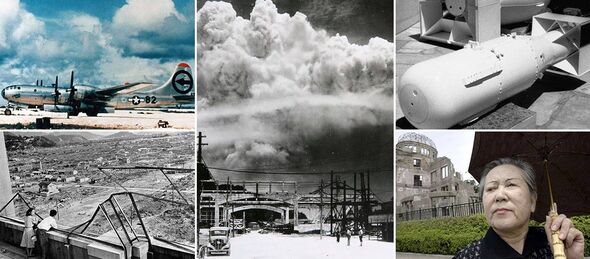

Eighty years ago, on 15 August, VJ Day marked the end of World War Two, a victory that came at an unimaginable human cost.
At 8.15am on 6 August 1945, over 70,000 people were instantly killed when an atomic bomb, known as 'Little Boy', was dropped on Hiroshima, Japan. A further 40,000 lives were claimed on 9 August when a second bomb hit Nagasaki.
In the ensuing months and years, the death toll continued to climb as residents succumbed to injuries, radiation poisoning and cancer. Now, we delve into the events of those two horrific days, through the eyes of the survivors just days after a Hiroshima atomic bomb survivor warns world is now in its 'most dangerous era'.
Read more: ‘Masterpiece’ period drama billed as ‘greatest adaptation’ like All Creatures
Read more: D-Day hero Don's emotional tribute to the fallen as he returns north of border
Methodist minister Kiyoshi Tanimoto rose at 5am on 6 August to assist a friend with moving furniture. An air raid siren briefly sounded as they strolled through the suburb of Nagaragawa, before signalling the all clear reports the Daily Star.
Then a "tremendous flash of light" streaked across the sky. There was no sound – almost no one in Hiroshima remembers the bomb making a noise.
At two miles from the epicentre of the explosion, both men had time to seek shelter.
The 36 year old flung himself between two rocks in a nearby garden, pressing his face against the stone. He felt a sudden pressure, then splinters and pieces of board began falling on him.
When he dared to lift his head, he saw the nearest house had collapsed. A thick, ominous dust cloud was descending.

In the early hours of 6 August, the B-29 bomber Enola Gay, named after the mother of pilot Paul Tibbets, a 30 year old colonel in the US Air Force, took off from Tinian Island in the Pacific Ocean.
Six hours later, it reached its target. As the bomb left the aircraft, Paul steered it into a steep climb to put as much distance as possible between his crew and the explosion.
When they felt a shockwave rattle the plane, they knew their mission had been a success. "We turned around to take a look," said Paul.
"The sight that greeted our eyes was quite beyond what we expected.

"We saw this cloud of boiling dust and debris below us with this tremendous mushroom on top. Beneath that was hidden the ruins of the city of Hiroshima."
Like many students, 15 year old Taeko Teramae had been drafted in to fill wartime labour shortages. She was working on the second floor of Hiroshima's Telephone Bureau when she heard a "tremendous noise."
The walls collapsed, blanketing the workers in darkness. Smoke filled the air and Taeko started choking, then vomiting uncontrollably.
Suddenly, she heard the voice of teacher Chiyoko Wakita, who called out: "We must endure this, like the proud scholars that we are!" Comforted, Taeko calmed down enough to reach a window.

She climbed through and slid down a telegraph pole, to a city "engulfed in a sea of fire."
With the only bridge across the Kyobashi River in flames, she and her teacher had to swim to safety.
Ms Wakita bravely returned to assist other students after dropping Taeko at an evacuation centre. Tragically, she succumbed to her injuries on 30 August.

In the weeks leading up to the Nagasaki bombing, Sachiko Matsuo's father discovered a leaflet dropped by American pilots. The chilling message warned that the city would "fall to ashes" on 8 August.
Taking the warning seriously, he constructed a makeshift cabin on a nearby mountain and pleaded with his family to seek refuge there. However, when the day passed without any incident, her mother and aunt decided to return home.
When the bomb – ominously nicknamed 'Fat Man' – struck Nagasaki at 11.02am on 9 August, only those who had stayed in the cabin were spared. Sachiko remembers witnessing a massive dust cloud ascending towards them from the devastated city.
She recalled: "My grandmother started to cry, 'Everybody is dead. This is the end of the world.'".

Her brother, who was serving with the city's civil defence unit, perished in the blast, and her father was severely injured. Although he managed to return to the cabin, he soon began showing signs of radiation sickness and tragically died on 28 August.
Tsutomu Yamaguchi, a resident of Nagasaki, remains the only recognised survivor of two nuclear bombs to this day. He was working in Hiroshima on 6 August when the initial explosion rendered him unconscious and damaged his eardrums.
Shortly after, the 29 year old navigated through streets strewn with bodies to reach the station. On the train, he encountered a man holding an awkwardly wrapped bundle – which was revealed to be his wife's decapitated head.

"I want to take her home to her parents," he said.
Upon arriving in Nagasaki, Tsutomu received treatment for his burnt face and forearms, then deemed himself ready to work. He was narrating the bombing on August 9 when a familiar blinding flash engulfed the room.
Once again, he appeared relatively unscathed. However, in the following days, his hair began to fall out and the wounds on his arms became gangrenous due to radiation poisoning.
Over time, Tsutomu recovered and managed to lead a fairly normal life, passing away at the age of 93 in 2010.